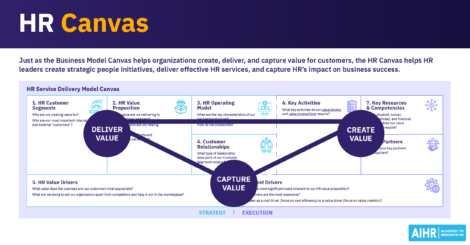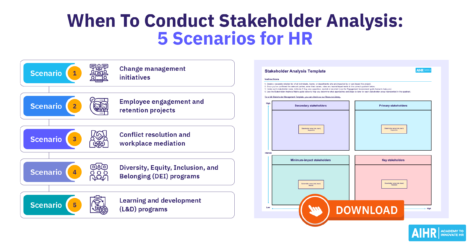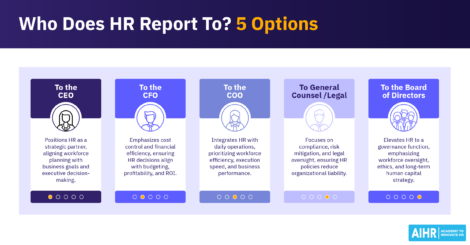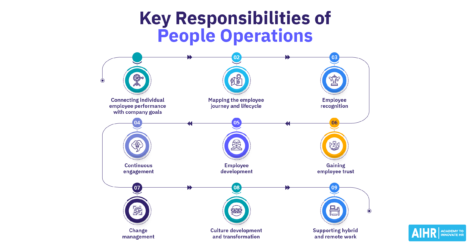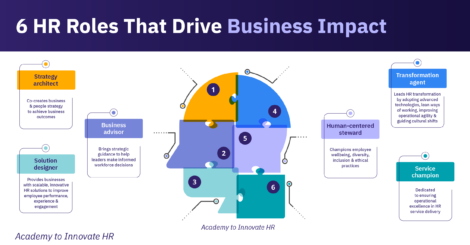HR Value Proposition: Examples & 8 Steps To Develop It
78% of HR professionals struggle with the perceived value of HR’s worth in organizations, and a further 58% say their organization’s leadership doesn’t fully recognize the value of HR work. This is where an HR value proposition can help bridge the gap.

Organizations must effectively attract, develop, and retain top talent if they want to achieve their strategic goals. An HR value proposition serves as a critical tool in this task, providing a clear and compelling narrative about the unique value that the HR function brings to both employees and the organization. Let’s take a detailed look at how you can create your HR value proposition.
Contents
What is an HR value proposition?
7 reasons why it’s important to have an HR value proposition
The HR value proposition model
How to develop your HR value proposition
HR value proposition examples
What is an HR value proposition?
An HR value proposition defines the unique benefits and contributions the HR function delivers to an organization and its employees. It highlights how HR supports the organization’s strategic objectives, drives goal achievement, and promotes a positive and unified organizational culture.
By aligning HR initiatives with the overall business strategy, the HR value proposition improves workforce capabilities, boosts employee engagement, and ensures a competitive edge through effective talent management, targeted training programs, and a supportive work environment.
An HR value proposition differs from employee value proposition (EVP). HR value proposition outlines the unique value HR brings to both employees and the organization by aligning HR initiatives with strategic goals and enhancing the employee experience, while an employee value proposition specifically focuses on the benefits and opportunities employees receive in exchange for their skills and contributions.
7 reasons why it’s important to have an HR value proposition
1. Build HR credibility and trust
You can position HR as a strategic business partner within your business by showcasing HR’s expertise and consistent contributions to organizational success.
When HR clearly communicates its value proposition, it highlights its role in driving key business outcomes, such as productivity and customer satisfaction. This transparency and reliability build trust among employees and leadership, making HR a reliable and integral part of the organization.
2. Set clear expectations
Communicating a well-defined HR value proposition sets clear expectations by outlining HR’s roles and responsibilities, reducing misunderstandings, and ensuring smooth operations through defined boundaries.
This clarity helps employees and management understand what support and services they can expect from Human Resources, which in turn reduces friction and enhances efficiency.
3. Align with organizational goals
When HR’s activities are in sync with the broader organizational strategy, it ensures that all efforts contribute to achieving the company’s vision and mission. This alignment not only optimizes the use of resources but also highlights the strategic importance of HR in achieving business success.
By demonstrating measurable impact, HR can validate its role in the organization, justifying investments in HR programs and initiatives.
4. Set direction and focus efforts
A clear HR value proposition serves as a roadmap, guiding HR professionals in aligning their activities with the organization’s strategic priorities. Directed by a robust value proposition, HR can avoid distractions and concentrate on high-impact areas that drive organizational performance.
5. Promote accountability
Outlining commitments and expected outcomes allows HR to set transparent benchmarks and performance indicators that can be tracked and measured. This accountability framework ensures that HR activities are consistently evaluated and improved, fostering a culture of excellence and continuous improvement.
Promoting accountability is crucial for maintaining high standards of service delivery, building trust in HR processes, and contributing meaningfully to the organization’s success through HR initiatives.
6. Enhance employee engagement and retention
Clearly articulating the benefits and support employees can expect from the HR function builds a positive employee experience.
When employees feel valued and supported through well-defined HR policies and initiatives, they are more likely to be engaged and remain with the company for longer periods. High levels of engagement and retention are also important for maintaining a stable and motivated workforce.
7. Facilitate change management
A solid HR value proposition highlights HR’s involvement in guiding an organization through transitions, such as mergers, acquisitions, or internal restructuring, ensuring that employees receive the necessary support and communication during times of change.
Effective change management minimizes disruptions and helps maintain employee morale and productivity.
The HR value proposition model
Osterwalder et al’s Value Proposition Canvas is a strategic tool designed to help businesses create compelling value propositions that resonate with their customers. The canvas consists of two main sections, the Customer Profile and the Value Map, which you can customize for HR and your two key customers: the organization (and its management) and employees.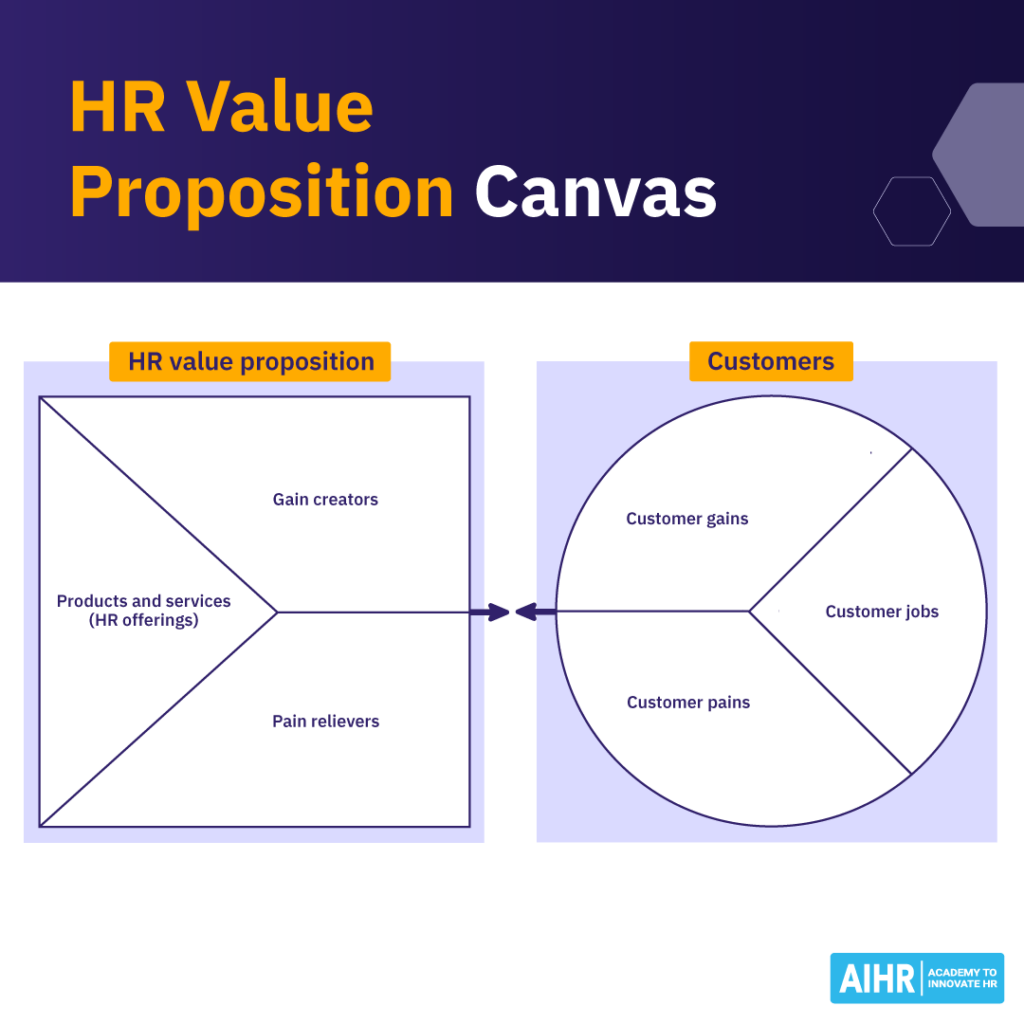
To complete the canvas, start with the customer profile and outline their:
- Jobs (tasks or problems they need to address)
- Pains (challenges or difficulties they face)
- Gains (benefits they are looking for).
Remember, HR has two customer groups, management, and employees, so you will need to complete this step for each distinct group.
The HR value map details:
- The products and services the business offers
- Pain relievers (how the offerings address customer challenges)
- Gain creators (how the offerings provide benefits).
These two sections are then aligned to create a cohesive HR value proposition that addresses employee and management pain points and provides clear benefits.
Below is an HR value proposition example with sample elements: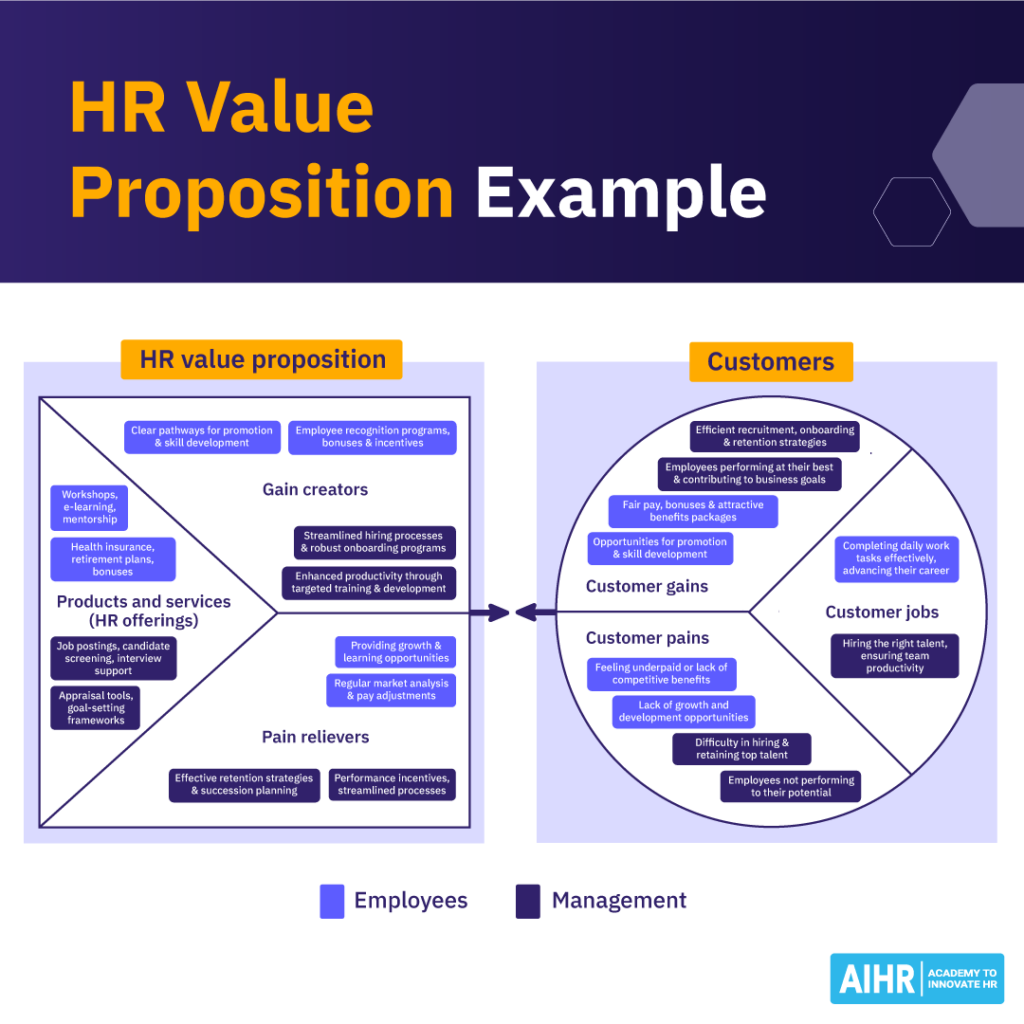
How to develop your HR value proposition
Here is a simple 8-step process to create your own HR value proposition:
1. Understand the business context
Start by understanding the business context. This involves thorough research and analysis of the company’s strategic objectives, mission, and vision. Understanding where the company is headed will help ensure that the HR value proposition aligns with these goals while analyzing industry trends and challenges can provide insights into external factors that might impact HR strategies.
Let’s take a manufacturing business as an example. The company’s goals could include increasing production efficiency, adopting sustainable manufacturing practices, and expanding into international markets.
The industry trends they would need to consider could be advancements in automation technology, the growing emphasis on sustainability, and global supply chain challenges.
2. Identify key stakeholders
Gather insights from employees at all levels through surveys, interviews, and focus groups to help you understand their needs, expectations, and pain points.
It is equally important to discuss HR expectations and managers’ perspectives on talent acquisition, development, retention, and overall workforce management with leadership and managers.
3. Conduct a needs assessment
For employees, determine what they value most in their workplace, their career aspirations, and any pain points they experience. For management, understanding their priorities in terms of talent management and overall workforce efficiency is crucial.
You can also identify any existing gaps or issues in current HR practices that need to be addressed. This comprehensive needs assessment will be your foundation for developing targeted HR initiatives.
4. Define the customer segments
For employees, consider segmenting based on roles, levels, and departments to tailor the value proposition to different groups within the organization. For management, segment by leadership levels, such as senior executives and middle managers. This segmentation ensures that the HR value proposition is relevant and impactful for all parts of the organization, addressing their unique needs and expectations.
5. Develop the value proposition based on the Value Proposition Canvas
Use the Value Proposition Canvas concept mentioned above to develop your proposition. Start by listing the jobs, or tasks and needs, of employees and management. Then, identify the pains, challenges, and obstacles they face, and the gains, benefits, and positive outcomes they seek.
Define the HR products and services that will help employees and management achieve their jobs and alleviate their pains. Specify how these offerings address the challenges identified (pain relievers) and how they create the desired benefits (gain creators). This detailed mapping ensures that the HR value proposition is comprehensive and aligned with stakeholder needs.
6. Align with organizational goals
Link HR initiatives directly to the organization’s broader strategic goals. This alignment ensures that HR efforts contribute to the company’s overall success and helps optimize resource allocation.
If we look at our manufacturing business example from the first step, HR initiatives like implementing training programs for new automation technologies, developing sustainability-focused employee engagement programs, and enhancing global talent acquisition strategies would be closely aligned with the organization’s strategic direction and industry demands.
7. Implement and execute
Develop a detailed action plan that outlines the steps needed to roll out these initiatives. Assign specific roles and responsibilities to HR team members to ensure accountability and effective execution. This structured approach will help in systematically implementing the HR value proposition across the organization.
8. Monitor and evaluate
Define key performance indicators (KPIs) to track the success of HR initiatives and establish regular feedback mechanisms with employees and management. This will help you assess the effectiveness of the HR value proposition and identify areas for improvement.
HR value proposition examples
Let’s take a look at what an HR Value Proposition looks like in action using hypothetical technology sector and financial sector examples.
Technology sector: MBot Tech
MBot Tech is a leading innovator in the technology sector, dedicated to developing cutting-edge solutions that enhance business efficiency and user experience. The company is currently navigating significant operational challenges, including rapid technological advancements, cybersecurity threats, and a competitive talent market.
To overcome these obstacles, MBot Tech is focused on promoting a culture of continuous learning and innovation. By investing in employee development, implementing robust cybersecurity measures, and supporting a collaborative work environment, MBot Tech aims to attract and retain top talent. This strategic approach ensures that MBot Tech remains at the forefront of the industry, delivering high-quality, secure technological solutions to its clients.
Here’s what their HR value proposition draft could look like:
Customer jobs
- Executing projects
- Pursuing career growth
- Driving innovation
- Building high-performing teams
- Employee engagement
- Retaining talent
Customer pains
High stress, burnout, unclear career paths, inadequate training for new technologies, poor communication, high job demands
High turnover, skill gaps in specialized tech fields, disengaged employees, maintaining high-performance standards, regulatory risks
Customer gains
Opportunities for career advancement, access to ongoing training and certifications, flexible work schedules, supportive culture, recognition for tech innovation excellence
A skilled and motivated workforce, alignment of employee performance with business goals, reduced turnover, enhanced employer brand, sustained high-quality product and service delivery
Products and services (HR offerings)
- Training programs focused on the latest technologies and industry practices
- Initiatives to support work-life balance through flexible schedules and remote work options
- Packages tailored to attract and retain top-tier tech talent
- Recruitment strategies to attract top tech professionals
- Tools to align individual performance with business objectives
- Ensuring adherence to industry standards and regulations through regular training
Pain relievers
- Providing clear career paths and growth opportunities in tech fields
- Offering support for managing stress and preventing burnout
- Regular updates and transparent communication to address poor communicatiom
- Training managers to provide better support and recognition, especially in high-stress environments
- Policies and practices to enhance job security and stability in a demanding industry
- Comprehensive talent management strategies to identify, develop, and retain high-potential employees
- Data analytics to forecast talent needs and address skill gaps proactively
- Targeted leadership training and mentorship programs to equip managers with the skills to lead effectively
- Robust change management frameworks to guide teams through technological and organizational changes
- Sophisticated performance measurement tools to track and analyze team productivity and effectiveness
- Protocols to identify, assess, and mitigate risks, particularly in cybersecurity and regulatory compliance
Gain creators
- Structured programs for continuous learning and career progression in tech
- Initiatives to acknowledge and reward excellence in innovation and performance
- Policies to support work-life balance, even in high-demand environments
- Activities and initiatives to boost employee engagement and foster a supportive work culture
- Programs to build a strong pipeline of future leaders in the tech industry
- Advanced analytics and market insights to inform strategic decisions and drive business growth
- Aligning organizational goals with market opportunities to stay ahead of industry trends and competitors
- Initiatives to boost employee engagement, satisfaction, and loyalty
- Cutting-edge collaboration tools to enhance communication and teamwork across the organization
- Cross-functional collaboration and knowledge sharing to drive innovation and efficiency
- Programs to recognize and reward outstanding performance and contributions
Financial sector: FinSmart
FinSmart is a financial services company specializing in investment management, wealth advisory, and banking services.
Despite its success, FinSmart faces significant challenges like high stress and burnout among employees, managing complex regulatory compliance, and retaining top financial talent. The company also deals with skill gaps in specialized fields, market volatility, and data security concerns.
To address these issues, FinSmart implements robust HR initiatives, comprehensive training, flexible work schedules, and wellness programs. These strategic initiatives aim to achieve both high performance and compliance with industry standards while fostering a supportive work environment.
Below is the starting point of their HR value proposition:
Customer jobs
- Delivering high-quality service
- Developing professional skills & navigating career paths
- Managing stress and workload
- Cross-team collaboration
- Strategic talent acquisition
- Boosting employee performance
- Driving business innovation
- Maintaining compliance
Customer pains
Difficulty keeping up with frequent regulatory changes, limited career mobility, inconsistent communication from management, inadequate technological support, and high pressure to meet targets
Rapid regulatory changes, gaps in compliance knowledge, disengaged workforce, difficulties in retaining top talent, and the need for constant process improvements
Customer gains
Clear pathways for career growth, regular training on regulatory updates and financial technologies, flexible work options, supportive and transparent culture, and recognition for regulatory compliance and customer satisfaction
Well-informed and compliant workforce, alignment of employee performance with regulatory and business goals, reduced turnover, enhanced reputation, and consistent high-quality customer service
Products and services (HR offerings)
- Regulatory training programs
- Technological support
- Flexible work arrangements
- Health and wellness programs
- Career path development
- Recruitment strategies focused on attracting top financial professionals with compliance expertise
- Robust performance management systems
- Comprehensive strategies to retain top talent and boost employee engagement
Pain relievers
- Clear communication channels
- Stress management support
- Financial technology training
- Job security measures
- Regulatory knowledge enhancement
- (Leadership) Talent development strategies
- Support in improving operational efficiency
Gain creators
- Flexible scheduling and remote work options to improve work-life balance
- Regular access to training and certification programs
- Initiatives to foster a collaborative and supportive work environment
- Leveraging market intelligence to gain insights into industry trends and customer behavior
- Ensuring employee activities align with strategic business and regulatory goals
- Initiatives to maintain and enhance the company’s reputation for attracting talent and customer service
- Feedback mechanisms to continuously improve employee performance
Key takeaway
Crafting a strong HR value proposition is about aligning HR initiatives with the organization’s strategic objectives, optimizing resource use and driving overall business success. Clearly articulating the HR value proposition builds credibility and trust and positions HR as a dependable partner of the organization. This, in turn, contributes to long-term sustainability and growth.
Learn more
Related articles
Are you ready for the future of HR?
Learn modern and relevant HR skills, online







